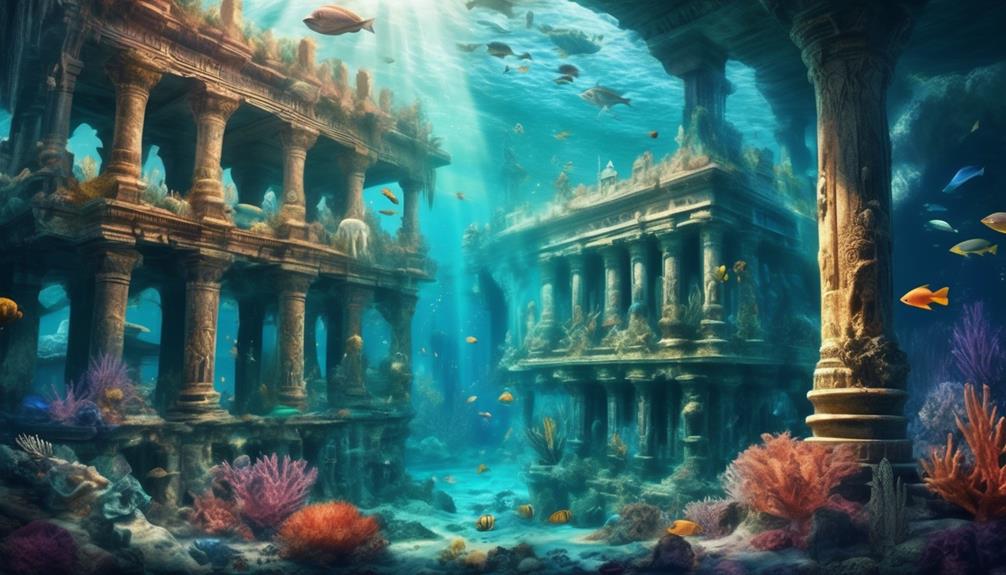Beneath the surface of ancient civilizations' lore lies a world both mysterious and captivating. From the depths of Sumerian water deities to the enchanting mermaids of Norse folklore, the tales of underwater kingdoms have woven themselves into the fabric of human storytelling.
As civilizations across the globe have looked to the seas and oceans, they have crafted rich and diverse narratives that speak of majestic underwater realms and the mythical beings that inhabit them.
Whether these stories were born out of a shared human fascination with the unknown or were inspired by real encounters with the depths, they continue to capture the imagination and curiosity of people today.
Key Takeaways
- Water deities played a central role in ancient civilizations like Sumer and Egypt, reflecting the importance of water for agriculture and transportation.
- Greek sea nymphs, known as Nereids, were depicted as graceful beings and played a significant role in ancient rituals for sailors' protection.
- Mermaids in folklore symbolize themes of love, transformation, and the mysteries of the sea, and are viewed as protectors of the waters in various indigenous communities.
- Underwater realms and mythical beings in different cultures, such as Egyptian, Chinese, and Pacific Islander, showcase the creativity and fantastical beliefs of ancient civilizations, conveying moral lessons and values through their stories.
Sumerian Water Deities
The Sumerian water deities played a significant role in the ancient Mesopotamian culture, shaping the beliefs and practices of the civilization. In Sumerian society, water was crucial for agriculture and transportation, and as such, it held a deeply spiritual significance.
The Sumerians believed in various water deities, such as Enki, the god of fresh water, and Nammu, the primeval mother of the sea. These deities were central to Sumerian water rituals, which were performed to ensure an adequate water supply for irrigation and to honor the gods believed to govern the rivers and seas.
The rituals also played a crucial role in the Sumerians' relationship with their environment and their understanding of the forces that governed their lives in the context of ancient river civilizations.
Greek Mythology and Sea Nymphs
In Greek mythology, sea nymphs, known as Nereids, were often depicted as graceful and alluring beings who inhabited the seas and accompanied the god of the sea, Poseidon, on his underwater adventures.
Sea nymphs were a popular subject in ancient Greek art, often portrayed as beautiful maidens with long flowing hair, surrounded by marine creatures and holding various aquatic symbols. They were a symbol of the sea's untamed beauty and were frequently featured in sculptures, paintings, and pottery.
Sea nymphs also played a significant role in ancient rituals, where they were believed to protect sailors and offer safe passage across the seas. These rituals often involved offerings and prayers to the sea nymphs to seek their favor and protection during maritime journeys.
Underwater Realms in Egyptian Legends
Deep within Egyptian mythology, the belief in underwater realms and mystical beings captivates the imagination with tales of hidden worlds beneath the waves. The ancient Egyptians held a deep reverence for the Nile River, believing it to be the source of life and a connection between the earthly realm and the afterlife.
Within this context, the concept of Egyptian underwater kingdoms and Nile River myths emerged, depicting a rich tapestry of deities and creatures associated with the waters. One prominent figure is Osiris, the god of the afterlife and rebirth, who was believed to reside in the underworld, often depicted alongside the Nile.
The goddess Tefnut, associated with moisture and fertility, also held a significant place in Egyptian mythology, symbolizing the vital role of water in sustaining life in both the earthly and spiritual realms.
Mermaids in Norse Folklore
Tales of underwater realms and mystical beings in ancient civilizations lore pave the way for a captivating exploration of mermaids in Norse folklore, shedding light on the rich tapestry of mythical creatures associated with the waters.
In Norse mythology, mermaids are known as 'maras' or 'merrows.' These creatures are often depicted as beautiful women with the lower body of a fish, luring sailors with their enchanting songs.
A fascinating aspect of Norse mermaid folklore is the concept of mermaid transformation. It's believed that a human could transform into a mermaid by donning a magical fish skin.
Norse sea creatures and mythology are replete with stories of mermaids interacting with both humans and other mythical beings, adding depth and complexity to the intricate tapestry of Norse folklore.
Pacific Islander Oceanic Folktales
Amidst the vast expanse of the Pacific Ocean, Pacific Islander Oceanic folktales weave a rich tapestry of vibrant narratives and ancestral wisdom, entwined with the rhythm of the sea and the spiritual essence of the islands.
These oceanic storytelling traditions are deeply rooted in Indigenous perspectives, reflecting the cultural significance of the sea in Pacific Islander communities. The tales often feature mythical sea creatures like the sea turtle, shark gods, and the octopus, each holding a special place in the folklore. These creatures aren't merely fantastical beings but embody important moral lessons and values, serving as a bridge between the natural world and the spiritual realm.
Through these folktales, Pacific Islanders pass down their heritage, preserving their unique connection to the ocean and reinforcing the profound respect they hold for its mysteries and wonders.
Subaquatic Cities in Chinese Mythology
Chinese mythology is replete with captivating tales of subaquatic cities, which offer a fascinating glimpse into the cultural imagination and spiritual beliefs of ancient China. Ancient legends speak of magnificent cities hidden beneath the waters, populated by mythical creatures and ruled by powerful deities.
One such city is the mythological 'Lunggyaung,' believed to be located near modern-day Guangdong. It's said to be an enchanting underwater metropolis inhabited by dragon-like beings and adorned with breathtaking crystal palaces.
These tales not only serve as a testament to the creativity of ancient Chinese storytellers but also reflect the profound reverence for water and its mysterious depths in Chinese culture. The stories of subaquatic cities in Chinese mythology continue to captivate the imagination, offering a unique perspective on the spiritual and fantastical beliefs of ancient China.
Mermaid Folklore Across the Americas
The prevalence of mermaid folklore across the Americas underscores the enduring fascination with mythical aquatic beings in diverse cultures, serving as a testament to the universal allure of underwater realms and their inhabitants.
In the Caribbean, mermaid tales are deeply intertwined with indigenous influence, blending the mythical creatures of European folklore with the rich traditions of the indigenous peoples. These mermaid legends hold significant cultural importance, often symbolizing themes of love, transformation, and the mysteries of the sea.
In various indigenous communities, mermaids are viewed as protectors of the waters, embodying the balance between nature and humanity.
The stories of mermaids in the Americas not only reflect the region's diverse cultural tapestry but also highlight the enduring enchantment with the mysteries and wonders of the ocean.
Frequently Asked Questions
Are There Any Scientific Evidence or Discoveries That Support the Existence of Underwater Kingdoms in Ancient Civilizations?
There is scientific evidence from underwater archaeology supporting the existence of ancient civilizations, but no concrete proof of underwater kingdoms. Ancient myths and folklore often mention submerged cities, but their existence remains unverified.
What Are the Cultural and Historical Significance of Underwater Realms in Different Ancient Civilizations?
Underwater realms held cultural significance in various ancient civilizations, often representing the unknown and mystical. Historically, they feature in myths and legends, reflecting the human fascination with the mysteries of the deep and the allure of exploration.
How Did Ancient Civilizations Perceive the Relationship Between Humans and Underwater Deities or Creatures?
Ancient perceptions of the relationship between humans and underwater deities or creatures held significant cultural significance. Underwater creatures were often revered as powerful gods or feared as malevolent forces, shaping ancient civilizations' beliefs and rituals.
Have There Been Any Modern Interpretations or Adaptations of Ancient Underwater Folklore in Literature or Art?
Modern adaptations of ancient underwater folklore are prevalent in literature and art. Literary interpretations and artistic representations draw heavily from folklore influences, depicting vivid and enchanting underwater kingdoms inspired by the lore of ancient civilizations.
What Role Did Underwater Kingdoms Play in the Religious or Spiritual Beliefs of Ancient Civilizations?
Underwater kingdoms held significant religious symbolism in ancient civilizations. Mythological creatures and underwater rituals were part of spiritual connections. These beliefs often reflected the divine power of water and the mysteries of the deep.

